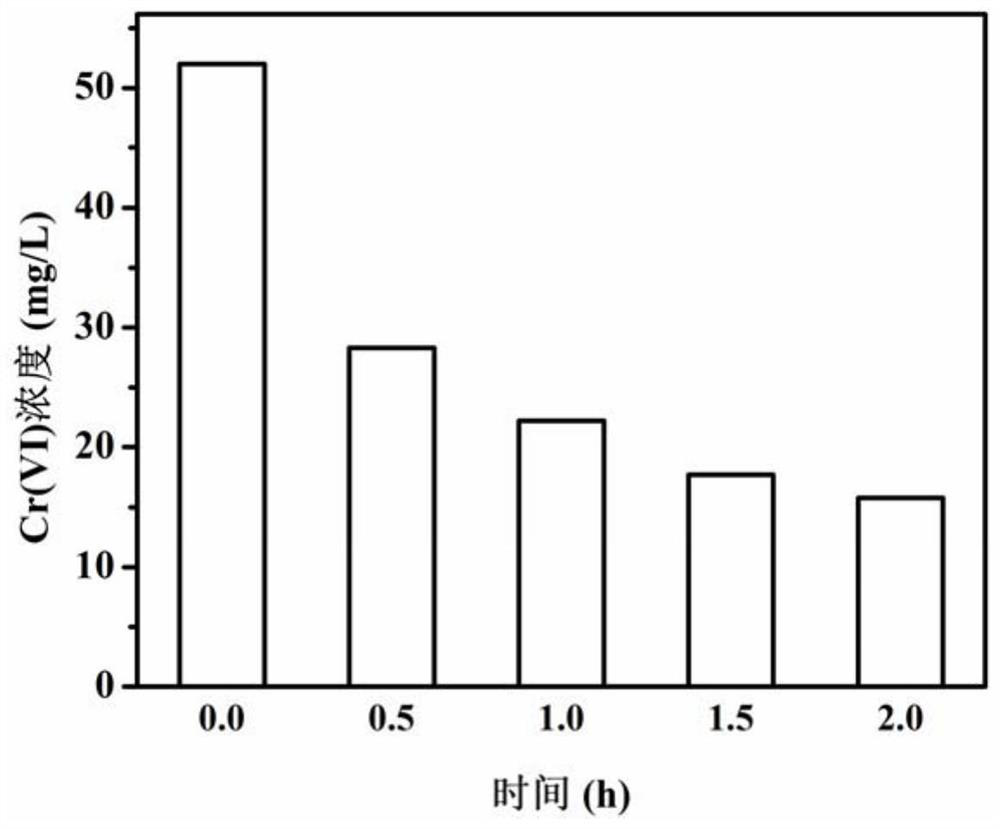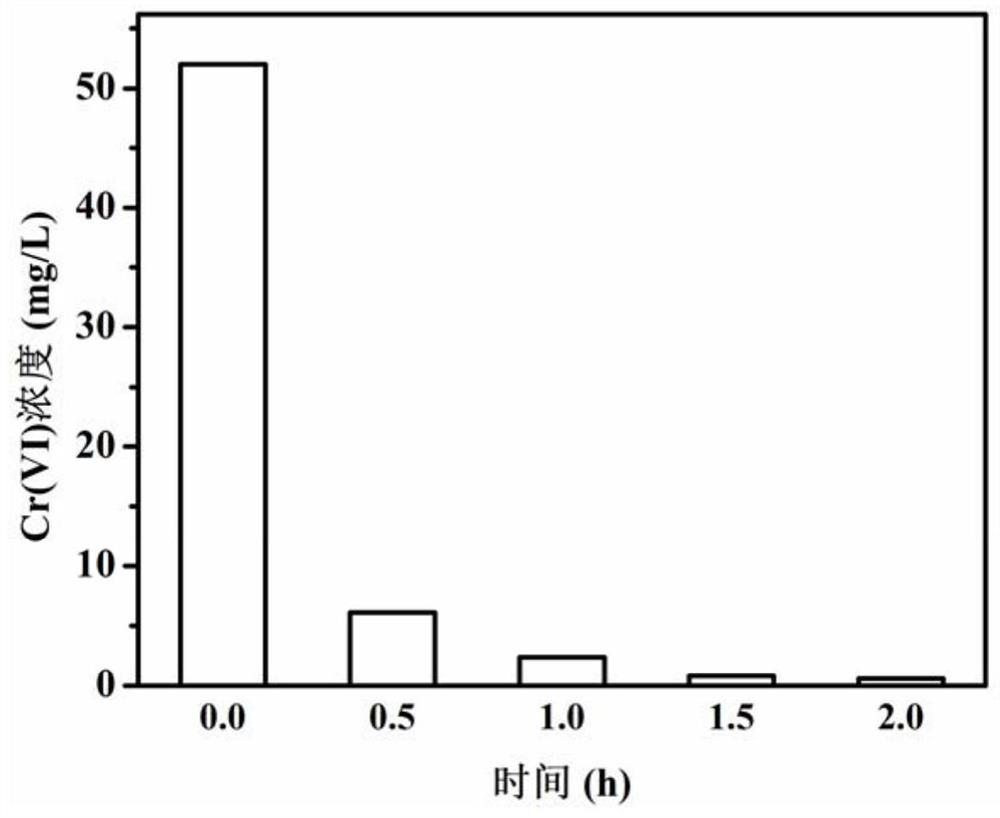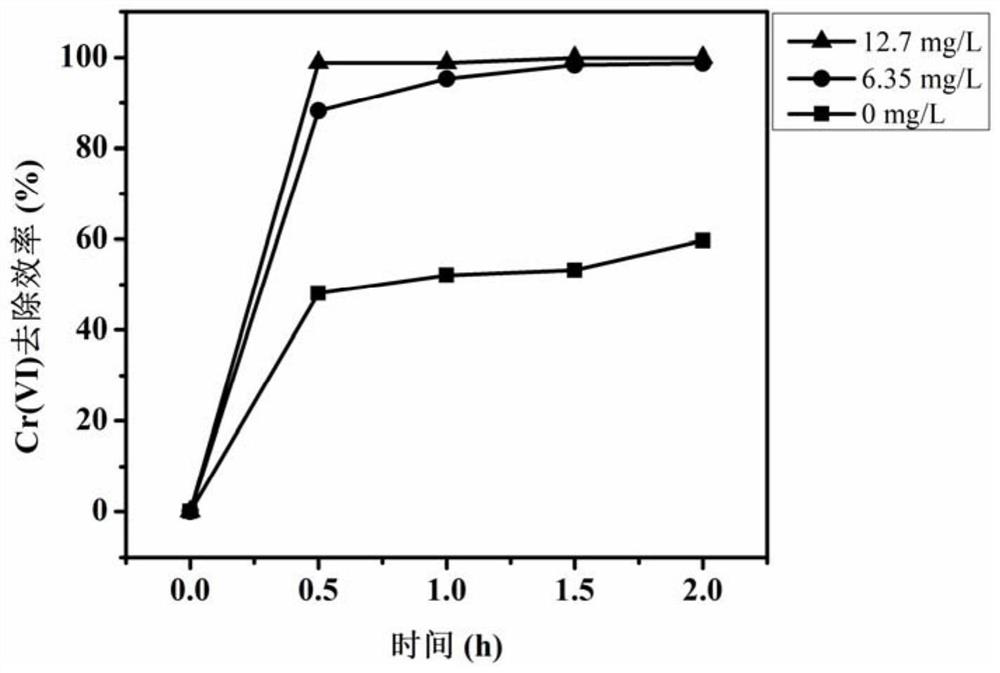Copper ions accelerate fructose-k 2 hpo 4 Product treatment method for chromium-containing wastewater
A technology of -K2HPO4 and copper ions, applied in the field of environmental pollution control, can solve the problems of expensive chemical reduction agents, waste of resources, secondary pollution, etc., and achieve simple and easy-to-control reaction process, efficient treatment and resource recovery, and reaction rate fast effect
- Summary
- Abstract
- Description
- Claims
- Application Information
AI Technical Summary
Problems solved by technology
Method used
Image
Examples
Embodiment 1
[0033] This embodiment discloses a copper ion accelerated fructose-K 2 HPO 4 The method of product treatment chromium-containing wastewater, such as Image 6 As shown, the steps are as follows:
[0034] 1. Prepare simulated wastewater with a Cr(VI) concentration of 52mg / L
[0035] 0.368g K 2 Cr 2 o 7 Dissolve in 5mL deionized water to make the concentration of Cr(VI) mother liquor be 26g / L; 0.085gCuCl 2 Be dissolved in 5mL deionized water, make the concentration of Cu(II) mother liquor be 6.35g / L; 3g K 2 HPO 4Dissolve in 20mL deionized water so that K 2 HPO 4 The concentration of mother liquor is 150g / L; Add 0.2g fructose and 200μL K to 20mL of deionized water 2 HPO 4 , reacted at 121°C for 20 min, and after cooling to room temperature, 40 μL of Cr(VI) mother liquor and 20 μL of Cu(II) mother liquor were added to prepare simulated wastewater. Simulated wastewater contains 1% fructose, 1.5g / L K 2 HPO 4 , 52mg / L of Cr(VI) and 6.35mg / L of Cu(II)
[0036] 2. Measuri...
Embodiment 2
[0039] 1. Measuring Fructose-K 2 HPO 4 Reduction effect of thermal reaction products on Cr(VI) in real wastewater
[0040] The real wastewater is coking wastewater from a steel plant. Its basic water quality parameters are as follows: COD 300mg / L, volatile phenol 30mg / L, conductivity 5000μS / cm, total salinity 2600, pH 7.9. Add 0.2 g fructose and 200 μL K to 20 mL of wastewater 2 HPO 4 , reacted at 121° C. for 20 min, and added 40 μL of Cr(VI) mother liquor and 20 μL of Cu(II) mother liquor after cooling to room temperature. Real wastewater contains 1% fructose, 1.5g / L of K 2 HPO 4 , 52mg / L of Cr(VI) and 6.35mg / L of Cu(II) and various organic compounds. Also take 1mL of real wastewater and mix it with 1mL of Cr(VI) chromogen, measure the absorbance value at a wavelength of 540nm with a spectrophotometer, and then measure it every 0.5h. The Cr(VI) concentration was calculated using the standard curve to obtain the reduction efficiency of Cr(VI). Experimental results such...
Embodiment 3
[0048] Removal of Organic Trivalent Chromium and Cu(II) from Treated Wastewater by Mn(II)
[0049] 1. Preparation of Mn(II) mother liquor
[0050] 0.9896g of manganese chloride tetrahydrate was dissolved in 5mL of deionized water so that the concentration of Mn(II) was 54.9g / L.
[0051] 2. Research on the removal of organic trivalent chromium and Cu(II) in treated wastewater by Mn(II)
[0052] Add 100 μL of Mn(II) mother liquor to the 20mL wastewater system, so that the concentration of Mn(II) in the system is 137.3mg / L, and wait for Mn(II) to react with organic trivalent chromium and Cu(II) in the wastewater for 10min, Samples were taken at 20min, 2h, 6h, and 12h, and the solution was centrifuged for 10min at a speed of 5000r / min, and the supernatant was taken to measure the Cr(VI) concentration, total chromium concentration and total copper concentration respectively. Measured in the same way as before, the concentrations of total chromium and total copper were measured by...
PUM
 Login to View More
Login to View More Abstract
Description
Claims
Application Information
 Login to View More
Login to View More - R&D
- Intellectual Property
- Life Sciences
- Materials
- Tech Scout
- Unparalleled Data Quality
- Higher Quality Content
- 60% Fewer Hallucinations
Browse by: Latest US Patents, China's latest patents, Technical Efficacy Thesaurus, Application Domain, Technology Topic, Popular Technical Reports.
© 2025 PatSnap. All rights reserved.Legal|Privacy policy|Modern Slavery Act Transparency Statement|Sitemap|About US| Contact US: help@patsnap.com



